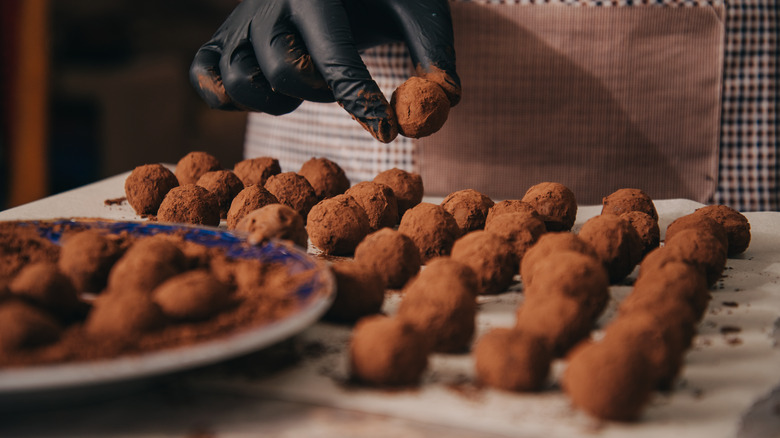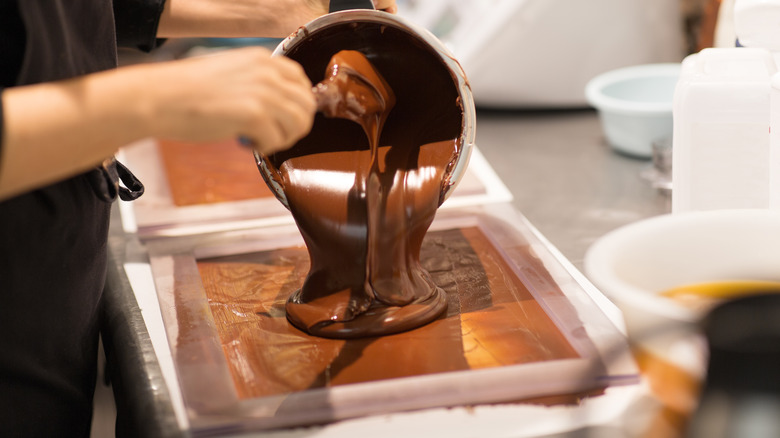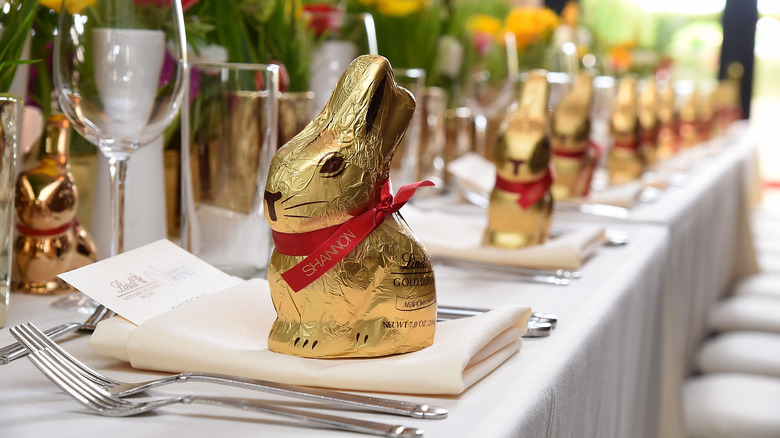How Lindt Changed The Chocolate Industry Forever
Uniform chocolate bars lined up in a candy store like shiny cocoa soldiers are something that we all take for granted. It's easy to overlook the fact that, once upon a time, the pleasure of slowly unwrapping a satiny smooth bar of chocolate from its blanket of gold foil wasn't actually a thing. Some genius had to come up with the idea, as chocolate actually had a "before" era when it was much rougher than the velvety indulgences we know today.
As explained by Lindt, up until the 1870s, chocolate tended to be dark, brittle and hand-molded — Godiva it was not. The texture was crumbly rather than solid, and it had difficulty retaining its shape. And as described by New Food Magazine, this unrefined chocolate tended to be dry and flaky, with less nuance in its cocoa flavors. Christiano Souza, an emulsifier at the Kerry Group writes in LinkedIn that chocolate in the mid-19th century actually had a kind of sandy texture, making it quite chewy and tricky to eat. It just didn't have the melt-in-the-mouth quality that we know and love today, and was rustic, but not in a charming way.
So what changed? It all started with the son of a Swiss pharmacist and confectioner, who had a beautiful vision of what chocolate could actually be.
The accidental discovery that transformed chocolate
Michelangelo said that when he looked at a rough block of marble, he could see the "lovely apparition" of the sculpture hidden within it (via A-Z Quotes). Twenty-four-year-old Rodolphe Lindt was the candy artiste equivalent, in that he looked at the rough, crumbly chocolate slabs of the day and knew they had the potential to be smoother, silkier, and altogether more seductive. So, according to Snack History, in 1879 he set up two factories in Berne, beginning his experiments with cocoa and sugar.
Yet, as explained by Kerry Group, the actual invention of smoother chocolate happened by accident after an employee left a mixing machine on over the weekend. When Rodolphe arrived at the factory on Monday, a strange aroma wafted towards him and he found the vat filled with an alluring pool of chocolate. And after tasting this whipped and melted batch, he knew that his quest was over — and that is how the process of chocolate "conching" was invented.
Why conching makes chocolate taste sublime
If you've ever visited a chocolate factory and been mesmerized by the machine that churns it around and around in a vat, you've seen conching in action. As explained by Lindt, this process changed everything, as it created the smooth melt-in-the-mouth chocolate that made their brand famous. According to Grenada Chocolate, conching is essentially a lengthy mechanized process where heated liquid chocolate is mixed, agitated, and aerated. This allows the more astringent elements of the cocoa solids to vanish into vapor, leaving behind a smoother, sweeter product with more depth of flavor. What's more, you can mold it into just about any shape you like, from bars to truffle shells.
Luker Chocolate further explains that conching gives tiny particles of cocoa, sugar, and milk solids a more uniform shape, so that they can be more evenly coated with cocoa butter. The result? A creamier chocolate that is ready to melt at the first contact with your mouth. Overall, conching is responsible for much of the enticing taste, texture, and experience of contemporary chocolate.
So next time you're biting into the ear of a Lindt Bunny, remember — if it hadn't been for an absent-minded factory worker in 1870s Berne, that chocolatey rabbit wouldn't even exist.


